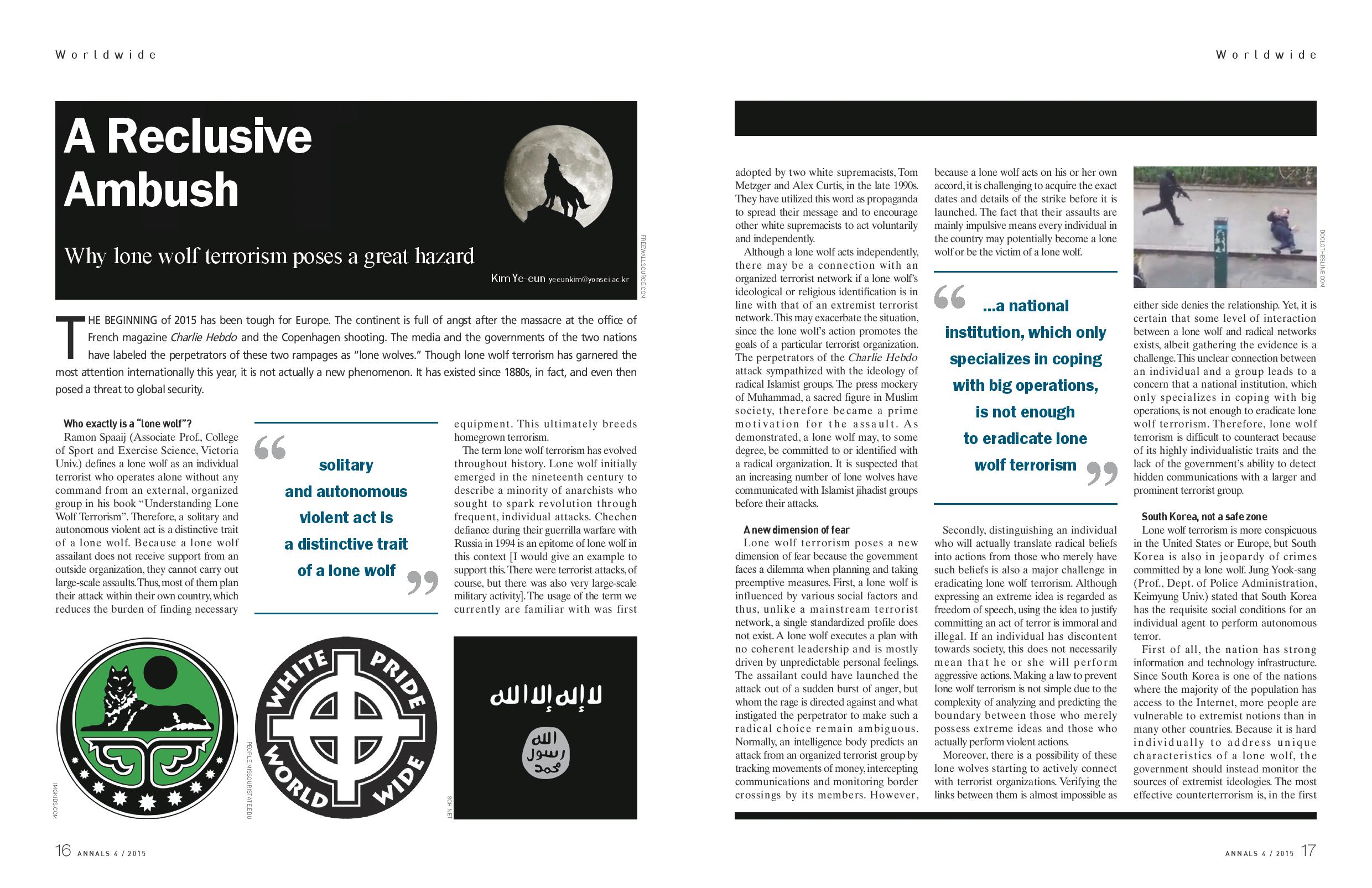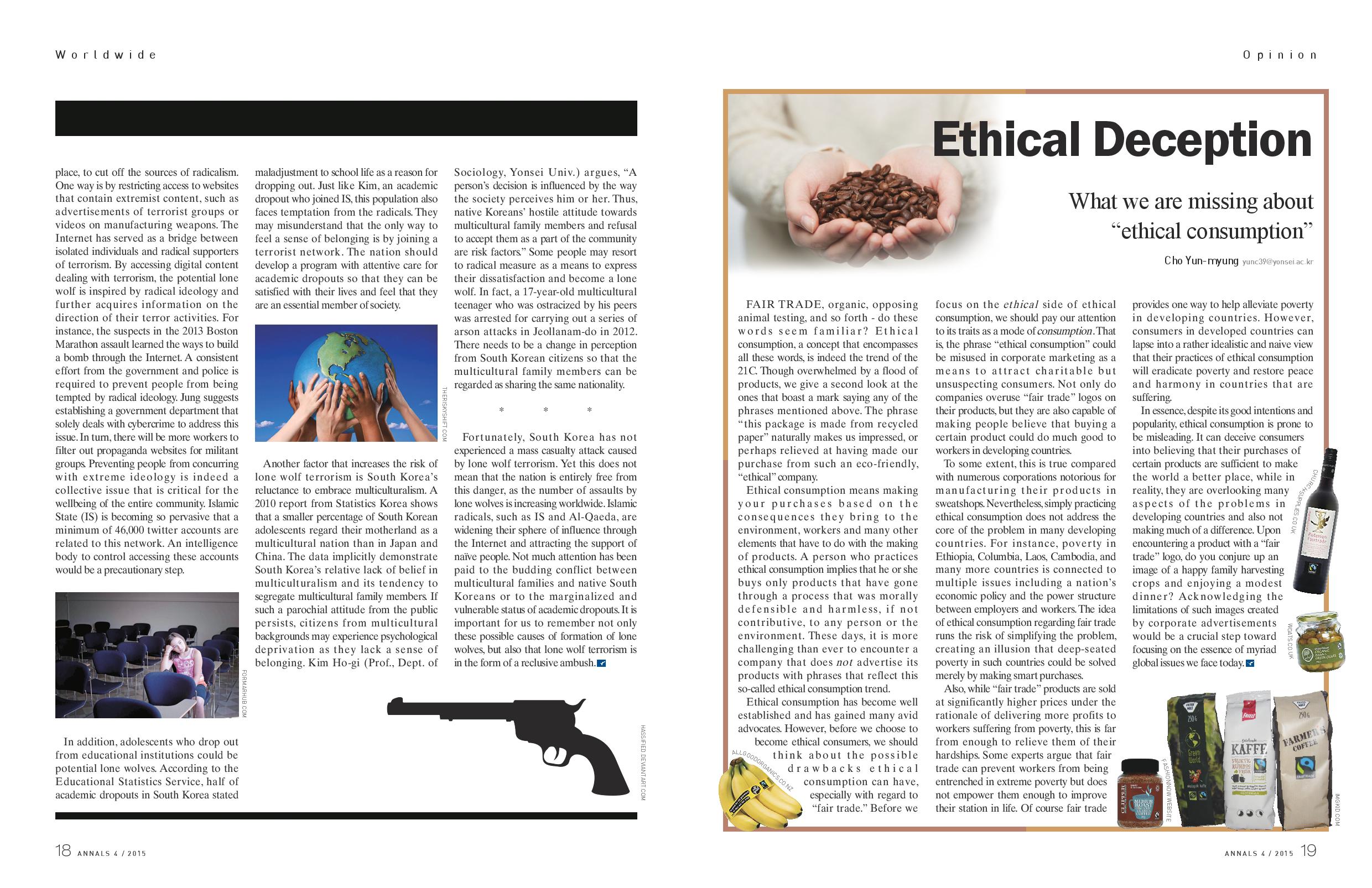Why lone wolf terrorism poses a great hazard
 | ||
 | ||
 | ||
THE BEGINNING of 2015 has been tough for Europe. The continent is full of angst after the massacre at the office of French magazine Charlie Hebdo and the Copenhagen shooting. The media and the governments of the two nations have labeled the perpetrators of these two rampages as “lone wolves.” Though lone wolf terrorism has garnered the most attention internationally this year, it is not actually a new phenomenon. It has existed since 1880s, in fact, and even then posed a threat to global security.
Who exactly is a “lone wolf”?
Ramon Spaaij (Associate Prof., College of Sport and Exercise Science, Victoria Univ.) defines a lone wolf as an individual terrorist who operates alone without any command from an external, organized group in his book “Understanding Lone Wolf Terrorism”. Therefore, a solitary and autonomous violent act is a distinctive trait of a lone wolf. Because a lone wolf assailant does not receive support from an outside organization, they cannot carry out large-scale assaults. Thus, most of them plan their attack within their own country, which reduces the burden of finding necessary equipment. This ultimately breeds homegrown terrorism.
The term lone wolf terrorism has evolved throughout history. Lone wolf initially emerged in the nineteenth century to describe a minority of anarchists who sought to spark revolution through frequent, individual attacks. Chechen defiance during their guerrilla warfare with Russia in 1994 is an epitome of lone wolf in this context. The usage of the term we currently are familiar with was first adopted by two white supremacists, Tom Metzger and Alex Curtis, in the late 1990s. They have utilized this word as propaganda to spread their message and to encourage other white supremacists to act voluntarily and independently.
Although a lone wolf acts independently, there may be a connection with an organized terrorist network if a lone wolf’s ideological or religious identification is in line with that of an extremist terrorist network. This may exacerbate the situation, since the lone wolf’s action promotes the goals of a particular terrorist organization. The perpetrators of the Charlie Hebdo attack sympathized with the ideology of radical Islamist groups. The press mockery of Muhammad, a sacred figure in Muslim society, therefore became a prime motivation for the assault. As demonstrated, a lone wolf may, to some degree, be committed to or identified with a radical organization. It is suspected that an increasing number of lone wolves have communicated with Islamist jihadist groups before their attacks.
A new dimension of fear
Lone wolf terrorism poses a new dimension of fear because the government faces a dilemma when planning and taking preemptive measures. First, a lone wolf is influenced by various social factors and thus, unlike a mainstream terrorist network, a single standardized profile does not exist. A lone wolf executes a plan with no coherent leadership and is mostly driven by unpredictable personal feelings. The assailant could have launched the attack out of a sudden burst of anger, but whom the rage is directed against and what instigated the perpetrator to make such a radical choice remain ambiguous. Normally, an intelligence body predicts an attack from an organized terrorist group by tracking movements of money, intercepting communications and monitoring border crossings by its members. However, because a lone wolf acts on his or her own accord, it is challenging to acquire the exact dates and details of the strike before it is launched. The fact that their assaults are mainly impulsive means every individual in the country may potentially become a lone wolf or be the victim of a lone wolf.
Secondly, distinguishing an individual who will actually translate radical beliefs into actions from those who merely have such beliefs is also a major challenge in eradicating lone wolf terrorism. Although expressing an extreme idea is regarded as freedom of speech, using the idea to justify committing an act of terror is immoral and illegal. If an individual has discontent towards society, this does not necessarily mean that he or she will perform aggressive actions. Making a law to prevent lone wolf terrorism is not simple due to the complexity of analyzing and predicting the boundary between those who merely possess extreme ideas and those who actually perform violent actions.
Moreover, there is a possibility of these lone wolves starting to actively connect with terrorist organizations. Verifying the links between them is almost impossible as either side denies the relationship. Yet, it is certain that some level of interaction between a lone wolf and radical networks exists, albeit gathering the evidence is a challenge. This unclear connection between an individual and a group leads to a concern that a national institution, which only specializes in coping with big operations, is not enough to eradicate lone wolf terrorism. Therefore, lone wolf terrorism is difficult to counteract because of its highly individualistic traits and the lack of the government’s ability to detect hidden communications with a larger and prominent terrorist group.
South Korea, not a safe zone
Lone wolf terrorism is more conspicuous in the United States or Europe, but South Korea is also in jeopardy of crimes committed by a lone wolf. Jung Yook-sang (Prof., Dept. of Police Administration, Keimyung Univ.) stated that South Korea has the requisite social conditions for an individual agent to perform autonomous terror.
First of all, the nation has strong information and technology infrastructure. Since South Korea is one of the nations where the majority of the population has access to the Internet, more people are vulnerable to extremist notions than in many other countries. Because it is hard individually to address unique characteristics of a lone wolf, the government should instead monitor the sources of extremist ideologies. The most effective counterterrorism is, in the first place, to cut off the sources of radicalism. One way is by restricting access to websites that contain extremist content, such as advertisements of terrorist groups or videos on manufacturing weapons. The Internet has served as a bridge between isolated individuals and radical supporters of terrorism. By accessing digital content dealing with terrorism, the potential lone wolf is inspired by radical ideology and further acquires information on the direction of their terror activities. For instance, the suspects in the 2013 Boston Marathon assault learned the ways to build a bomb through the Internet. A consistent effort from the government and police is required to prevent people from being tempted by radical ideology. Jung suggests establishing a government department that solely deals with cybercrime to address this issue. In turn, there will be more workers to filter out propaganda websites for militant groups. Preventing people from concurring with extreme ideology is indeed a collective issue that is critical for the wellbeing of the entire community. Islamic State (IS) is becoming so pervasive that a minimum of 46,000 twitter accounts are related to this network. An intelligence body to control accessing these accounts would be a precautionary step.
In addition, adolescents who drop out from educational institutions could be potential lone wolves. According to the Educational Statistics Service, half of academic dropouts in South Korea stated maladjustment to school life as a reason for dropping out. Just like Kim, an academic dropout who joined IS, this population also faces temptation from the radicals. They may misunderstand that the only way to feel a sense of belonging is by joining a terrorist network. The nation should develop a program with attentive care for academic dropouts so that they can be satisfied with their lives and feel that they are an essential member of society.
Another factor that increases the risk of lone wolf terrorism is South Korea’s reluctance to embrace multiculturalism. A 2010 report from Statistics Korea shows that a smaller percentage of South Korean adolescents regard their motherland as a multicultural nation than in Japan and China. The data implicitly demonstrate South Korea’s relative lack of belief in multiculturalism and its tendency to segregate multicultural family members. If such a parochial attitude from the public persists, citizens from multicultural backgrounds may experience psychological deprivation as they lack a sense of belonging. Kim Ho-gi (Prof., Dept. of Sociology, Yonsei Univ.) argues, “A person’s decision is influenced by the way the society perceives him or her. Thus, native Koreans’ hostile attitude towards multicultural family members and refusal to accept them as a part of the community are risk factors.” Some people may resort to radical measure as a means to express their dissatisfaction and become a lone wolf. In fact, a 17-year-old multicultural teenager who was ostracized by his peers was arrested for carrying out a series of arson attacks in Jeollanam-do in 2012. There needs to be a change in perception from South Korean citizens so that the multicultural family members can be regarded as sharing the same nationality.
* * *
Fortunately, South Korea has not experienced a mass casualty attack caused by lone wolf terrorism. Yet this does not mean that the nation is entirely free from this danger, as the number of assaults by lone wolves is increasing worldwide. Islamic radicals, such as IS and Al-Qaeda, are widening their sphere of influence through the Internet and attracting the support of naïve people. Not much attention has been paid to the budding conflict between multicultural families and native South Koreans or to the marginalized and vulnerable status of academic dropouts. It is important for us to remember not only these possible causes of formation of lone wolves, but also that lone wolf terrorism is in the form of a reclusive ambush.
Kim Ye-eun
yeeunkim@yonsei.ac.kr

